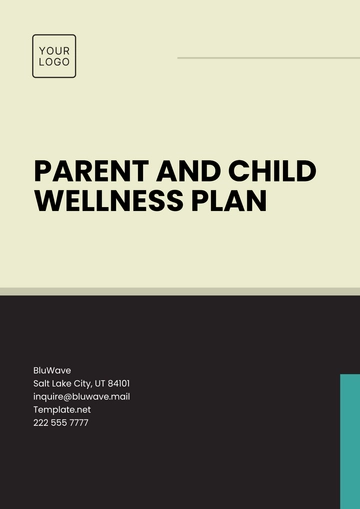Free Preventive Health and Wellness Plan

Prepared by: [Your Name]
Company: [Your Company Name]
Date: [Insert Date]
I. Introduction
Preventive health focuses on promoting wellness and preventing illness before it starts. The Preventive Health and Wellness Plan is designed to improve overall community health by providing education, resources, and strategies to reduce the risk of chronic diseases, manage lifestyle factors, and enhance quality of life. The plan emphasizes early detection, regular screenings, vaccination, and healthy lifestyle choices to prevent diseases such as heart disease, diabetes, and cancer.
II. Vision and Goals
A. Vision
To create a community that prioritizes prevention promotes healthy lifestyles, and reduces the burden of preventable diseases.
B. Goals
Promote Healthy Lifestyles: Encourage healthy behaviors such as regular physical activity, balanced nutrition, and mental well-being.
Reduce the Risk of Chronic Diseases: Implement strategies to lower the prevalence of chronic diseases like heart disease, diabetes, and cancer.
Increase Health Screenings and Early Detection: Ensure community members participate in regular health screenings to detect diseases early and prevent complications.
Promote Mental Health and Stress Management: Focus on the importance of mental wellness and stress management in preventing physical health issues.
Increase Vaccination Rates: Promote the importance of vaccinations to prevent infectious diseases.
Empower Individuals to Take Control of Their Health: Provide tools, education, and support to help individuals make informed health choices.
III. Key Areas of Focus and Strategies
A. Health Education and Awareness
Strategies:
Educational Campaigns: Launch campaigns focusing on the importance of preventive measures, such as vaccination, healthy eating, and regular physical activity.
Workshops and Seminars: Offer community workshops on topics like nutrition, exercise, mental health, and stress management.
Healthy Lifestyle Guides: Distribute brochures, booklets, and digital resources that provide clear guidelines on healthy living, including diet plans, exercise routines, and stress reduction techniques.
Community Health Fairs: Organize events where individuals can receive free educational materials, screenings, and consultations from health professionals.
B. Physical Health and Wellness
Strategies:
Physical Activity Promotion: Encourage individuals to engage in at least 150 minutes of moderate-intensity physical activity per week through community fitness programs, walking clubs, and outdoor activities.
Exercise Classes: Offer a variety of fitness classes, including yoga, Zumba, aerobics, and strength training, tailored to all fitness levels.
Nutrition Education and Support: Provide nutrition counseling, cooking classes, and meal planning workshops to teach healthy eating habits.
Weight Management Programs: Implement support groups and coaching for weight loss and weight maintenance, focusing on sustainable, healthy changes rather than fad diets.
Chronic Disease Prevention through Exercise: Develop programs that target high-risk populations (e.g., those with prediabetes, and hypertension) to help them manage risk factors through exercise.
C. Mental Health and Stress Management
Strategies:
Stress Reduction Programs: Offer stress management workshops that include techniques such as deep breathing, meditation, and mindfulness to help individuals cope with stress.
Mental Health Screening and Support: Screen for mental health conditions such as depression and anxiety and provide resources for individuals to seek help.
Support Groups: Create peer support groups for mental health, focusing on managing anxiety, depression, and stress through group discussions, education, and shared experiences.
Employee Wellness Programs: Promote workplace wellness programs that offer mental health support, stress management workshops, and employee assistance programs (EAPs).
Resilience Training: Offer classes or workshops on building emotional resilience, coping strategies, and developing a positive mindset to better manage life challenges.
D. Health Screenings and Preventive Services
Strategies:
Regular Health Screenings: Promote participation in routine screenings for conditions such as high blood pressure, high cholesterol, diabetes, and cancer (e.g., mammograms, colonoscopies, pap smears).
Vaccination Clinics: Provide accessible vaccination services for flu, HPV, hepatitis, and other preventable diseases to reduce the incidence of infectious diseases.
Early Detection Programs: Set up programs to encourage early detection of diseases such as breast cancer, colorectal cancer, and prostate cancer through regular screening.
Blood Pressure and Blood Sugar Monitoring: Offer free or low-cost blood pressure and blood glucose screenings in the community to detect early signs of hypertension and diabetes.
Skin Cancer Screenings: Provide annual or semi-annual skin cancer screenings to detect early signs of melanoma or other skin cancers.
E. Tobacco and Substance Use Prevention
Strategies:
Smoking Cessation Programs: Offer resources and support for individuals looking to quit smoking, including smoking cessation classes, nicotine replacement therapy, and counseling.
Substance Use Education: Raise awareness about the dangers of substance abuse and provide support and resources for individuals struggling with addiction.
Youth Prevention Programs: Develop programs in schools to educate children and teenagers about the dangers of smoking, alcohol, and drug use, and offer resources for prevention.
F. Health and Wellness for Vulnerable Populations
Strategies:
Community Health Workers: Deploy community health workers to reach underserved populations, provide education, and connect individuals to healthcare services and wellness programs.
Programs for Seniors: Offer tailored health programs for older adults, including fall prevention, bone health, managing chronic conditions, and mental wellness.
Family Health and Wellness: Provide family-focused wellness programs that promote healthy habits for parents and children, including meal planning, physical activity, and managing stress.
Support for Low-Income Families: Provide access to free or low-cost wellness services, including screenings, immunizations, and nutrition counseling, for low-income individuals and families.
IV. Implementation Plan
A. Roles and Responsibilities
Healthcare Providers: Offer medical screenings, provide counseling on healthy lifestyle choices, and offer immunizations and preventive care services.
Wellness Coaches: Provide individual coaching on fitness, nutrition, and mental health, and offer support for creating personalized wellness plans.
Community Health Workers: Serve as the primary connection between the community and healthcare services, promoting preventive health practices and connecting individuals to resources.
Local Governments and Public Health Authorities: Facilitate and fund community health initiatives, establish health policies, and support local wellness programs.
Nonprofit Organizations and Volunteers: Support wellness efforts by volunteering at events, leading health workshops, and helping to distribute health information.
B. Timeline
Phase 1 (Month 1-3): Launch awareness campaigns on the importance of prevention and schedule the first round of free health screenings.
Phase 2 (Month 4-6): Introduce regular fitness classes, cooking workshops, and smoking cessation programs.
Phase 3 (Month 7-12): Evaluate program effectiveness, increase outreach efforts, and expand access to mental health support and chronic disease prevention programs.
Ongoing: Maintain year-round screenings, vaccination drives, and wellness workshops. Continue to promote physical and mental health through ongoing community engagement.
V. Evaluation and Assessment
A. Key Performance Indicators (KPIs)
Health Screening Participation Rates: Track the number of individuals participating in health screenings, to increase participation annually.
Vaccination Coverage: Measure vaccination rates in the community, especially for flu and preventable childhood diseases.
Physical Activity Engagement: Monitor participation in community fitness programs and assess improvements in physical health and fitness.
Chronic Disease Incidence: Track the prevalence of chronic conditions such as diabetes and hypertension, aiming to reduce incidence through preventive measures.
Mental Health Outcomes: Measure engagement in mental health programs and the effectiveness of stress management strategies.
Healthy Lifestyle Adoption: Assess the adoption of healthier behaviors (e.g., improved diet, regular exercise, smoking cessation).
B. Methods of Evaluation
Surveys and Feedback: Collect feedback from participants through surveys, focus groups, and interviews to assess the effectiveness and satisfaction with wellness programs.
Health Outcome Tracking: Use data from health screenings and clinic visits to track improvements in health markers such as blood pressure, cholesterol, and weight.
Program Attendance: Track attendance and participation rates in workshops, fitness classes, and support groups to gauge interest and engagement.
Health Improvement Monitoring: Follow up with individuals who have participated in the program to monitor improvements in chronic disease management and overall health.
VI. Sustainability Plan
Community Partnerships: Collaborate with local healthcare providers, schools, and businesses to create long-term support for preventive health initiatives.
Funding and Grants: Seek funding through public health grants, private donations, and insurance partnerships to sustain wellness programs.
Volunteer Engagement: Encourage volunteerism to ensure the continued success of the program and expand its reach.
Ongoing Education and Support: Provide continuous education on preventive health and wellness through ongoing workshops, newsletters, and community events.
VII. Conclusion
The Preventive Health and Wellness Plan is designed to create a healthier community by emphasizing the importance of prevention, early detection, and healthy living. By offering education, resources, and support, this plan aims to reduce the burden of preventable diseases, improve overall well-being, and empower individuals to take control of their health. With collective effort and ongoing commitment, we can create a community that values wellness and embraces prevention as a way of life.
- 100% Customizable, free editor
- Access 1 Million+ Templates, photo’s & graphics
- Download or share as a template
- Click and replace photos, graphics, text, backgrounds
- Resize, crop, AI write & more
- Access advanced editor
You may also like
- Finance Plan
- Construction Plan
- Sales Plan
- Development Plan
- Career Plan
- Budget Plan
- HR Plan
- Education Plan
- Transition Plan
- Work Plan
- Training Plan
- Communication Plan
- Operation Plan
- Health And Safety Plan
- Strategy Plan
- Professional Development Plan
- Advertising Plan
- Risk Management Plan
- Restaurant Plan
- School Plan
- Nursing Home Patient Care Plan
- Nursing Care Plan
- Plan Event
- Startup Plan
- Social Media Plan
- Staffing Plan
- Annual Plan
- Content Plan
- Payment Plan
- Implementation Plan
- Hotel Plan
- Workout Plan
- Accounting Plan
- Campaign Plan
- Essay Plan
- 30 60 90 Day Plan
- Research Plan
- Recruitment Plan
- 90 Day Plan
- Quarterly Plan
- Emergency Plan
- 5 Year Plan
- Gym Plan
- Personal Plan
- IT and Software Plan
- Treatment Plan
- Real Estate Plan
- Law Firm Plan
- Healthcare Plan
- Improvement Plan
- Media Plan
- 5 Year Business Plan
- Learning Plan
- Marketing Campaign Plan
- Travel Agency Plan
- Cleaning Services Plan
- Interior Design Plan
- Performance Plan
- PR Plan
- Birth Plan
- Life Plan
- SEO Plan
- Disaster Recovery Plan
- Continuity Plan
- Launch Plan
- Legal Plan
- Behavior Plan
- Performance Improvement Plan
- Salon Plan
- Security Plan
- Security Management Plan
- Employee Development Plan
- Quality Plan
- Service Improvement Plan
- Growth Plan
- Incident Response Plan
- Basketball Plan
- Emergency Action Plan
- Product Launch Plan
- Spa Plan
- Employee Training Plan
- Data Analysis Plan
- Employee Action Plan
- Territory Plan
- Audit Plan
- Classroom Plan
- Activity Plan
- Parenting Plan
- Care Plan
- Project Execution Plan
- Exercise Plan
- Internship Plan
- Software Development Plan
- Continuous Improvement Plan
- Leave Plan
- 90 Day Sales Plan
- Advertising Agency Plan
- Employee Transition Plan
- Smart Action Plan
- Workplace Safety Plan
- Behavior Change Plan
- Contingency Plan
- Continuity of Operations Plan
- Health Plan
- Quality Control Plan
- Self Plan
- Sports Development Plan
- Change Management Plan
- Ecommerce Plan
- Personal Financial Plan
- Process Improvement Plan
- 30-60-90 Day Sales Plan
- Crisis Management Plan
- Engagement Plan
- Execution Plan
- Pandemic Plan
- Quality Assurance Plan
- Service Continuity Plan
- Agile Project Plan
- Fundraising Plan
- Job Transition Plan
- Asset Maintenance Plan
- Maintenance Plan
- Software Test Plan
- Staff Training and Development Plan
- 3 Year Plan
- Brand Activation Plan
- Release Plan
- Resource Plan
- Risk Mitigation Plan
- Teacher Plan
- 30 60 90 Day Plan for New Manager
- Food Safety Plan
- Food Truck Plan
- Hiring Plan
- Quality Management Plan
- Wellness Plan
- Behavior Intervention Plan
- Bonus Plan
- Investment Plan
- Maternity Leave Plan
- Pandemic Response Plan
- Succession Planning
- Coaching Plan
- Configuration Management Plan
- Remote Work Plan
- Self Care Plan
- Teaching Plan
- 100-Day Plan
- HACCP Plan
- Student Plan
- Sustainability Plan
- 30 60 90 Day Plan for Interview
- Access Plan
- Site Specific Safety Plan





























